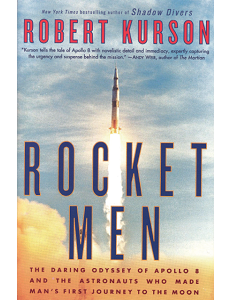The Apollo 8 mission of 1968 marked one of those important ‘firsts’ in manned spaceflight: it was the first time men from Earth had travelled to and around the Moon. This book tells the story of that historic mission by focusing on the three astronauts and their families; and places it in the political context of the riots and assassinations that troubled America at the time.
It’s clear from the Author’s Note that he was emotionally ‘sold’ on Apollo 8 from the moment he saw the recovered Command Module in a Chicago museum. Although he sees similarities in today’s political situation, he recognises that the mission itself provided a “significant difference”. “When Borman, Lovell, and Anders returned from the Moon”, he says, “few could argue… that they hadn’t seen something important and beautiful happen, that these three men had helped the country, and the world, to heal”. That statement may seem exaggerated to some readers, but those who lived through the Moon Race and the Cold War will identify.
The book is based on extensive interviews with the three crewmembers, two of their wives and other individuals such as former mission controller Chris Kraft. The author also made use of “eighty or more” of NASA’s oral histories, and other interview transcripts, so the book is well-researched. And he even got the three astronauts to fact-check the text! The volume is illustrated with a colour photo insert and has a useful index.
The writing style is novelistic and designed to grab the reader’s attention from the start. For example, chapter 1 begins: “As he sat on a beach in the Caribbean, a quiet engineer named George Low ran his fingers through the sand and wondered whether he should risk everything to win the Space Race and help save the world”. Two pages later the author describes Low’s mission in equally lyrical style: “to build a machine from the future that would help make the world safe for democracy”… but if you can ignore the strip-cartoon language of the early pages, it’s an interesting and engaging read.











